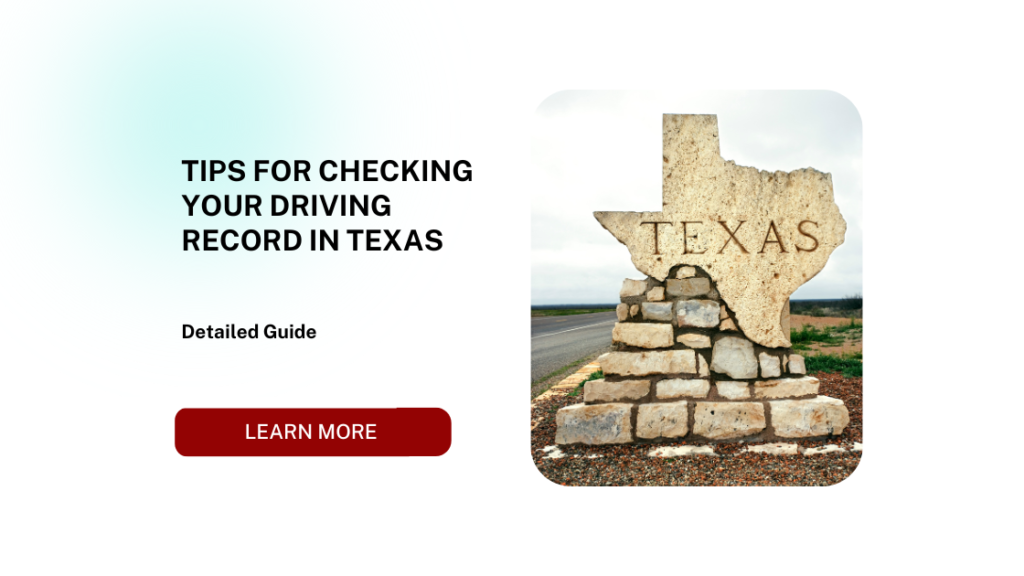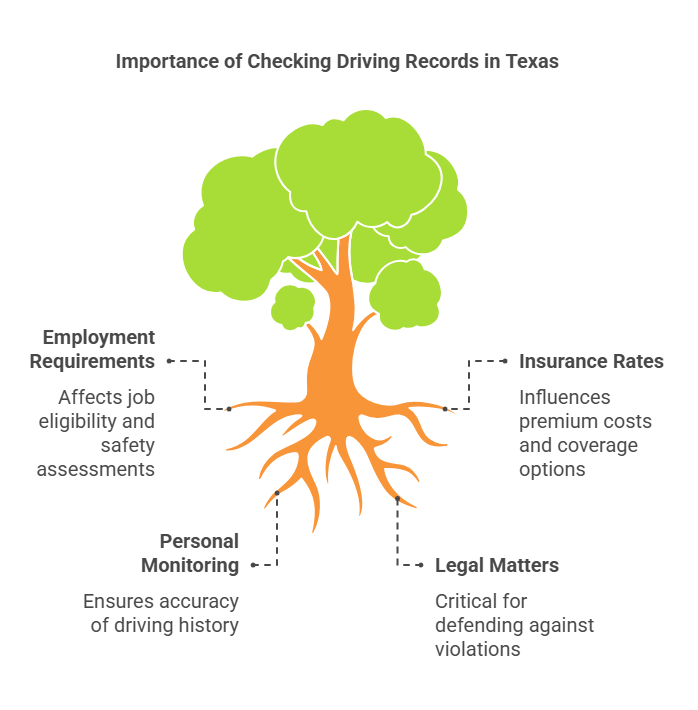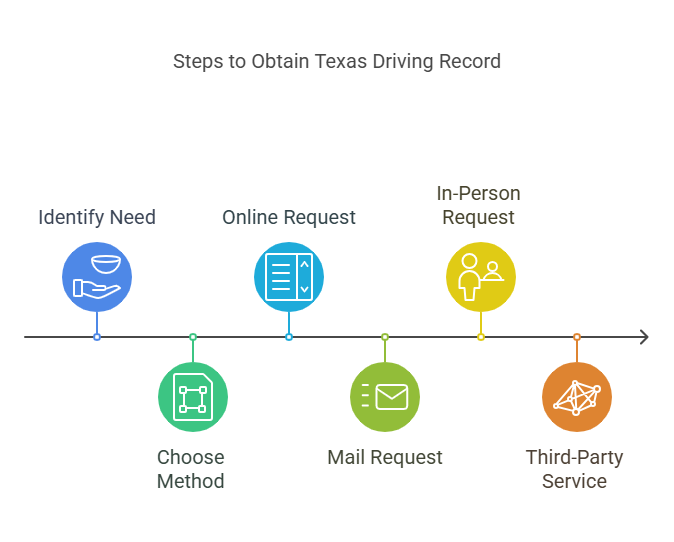Tips for Checking Your Driving Record in Texas

How to Check Your Driving Record in Texas: A Complete Guide
Your driving record is an essential document that reflects your history on the road. In Texas, as in many states, your driving record contains vital information such as traffic violations, accidents, DUI offenses, and the current status of your driver’s license. Having access to your driving record is important for a variety of reasons, ranging from employment purposes to personal monitoring of your driving history. In Texas, the Department of Public Safety (DPS) manages and maintains your driving record, offering various methods through which you can access this information.
Whether you are an individual wanting to verify the accuracy of your record, an employer conducting background checks, or someone checking their driving history for insurance purposes, knowing how to check your driving record in Texas is a crucial first step. This guide will walk you through everything you need to know about Texas driving records, the different methods available to access them, and the types of records you can request.
Why You Should Check Your Driving Record in Texas

There are many scenarios where checking your driving record in Texas can prove useful. Here are a few examples of why it’s important:
1. Employment Requirements
For those seeking employment, especially in roles where driving is a key responsibility (e.g., delivery drivers, truck drivers, rideshare drivers), employers often require a clean driving record. Many companies, especially those involved in logistics, transportation, or ridesharing, run background checks to verify whether applicants have a history of traffic violations, accidents, or other issues that might affect their ability to perform their duties safely.
Your driving record will be scrutinized by employers looking for candidates who have a good safety record, and a clean driving record can help you secure a job. If your record contains violations or accidents, it might impact your employment prospects, especially if the employer has a policy of hiring only individuals with clean driving histories.
2. Insurance Rates and Eligibility
Insurance companies use your driving record to assess how much of a risk you present as a driver. If your record shows multiple traffic violations or accidents, you may be classified as a high-risk driver, resulting in higher premiums or even the inability to obtain certain types of insurance. On the other hand, a clean driving history can often lead to discounts on your premiums.
Regularly checking your driving record ensures that your insurance rates are being calculated correctly. If there are any discrepancies, such as a misreported accident or an incorrect traffic violation, you can take steps to correct it and potentially lower your rates.
3. Personal Monitoring
Sometimes, people check their driving records simply for peace of mind. If you have been involved in an accident, received a ticket, or made a recent traffic violation, you may want to ensure that these events have been accurately recorded. It’s also a good practice to verify the accuracy of your driving history if you’ve recently changed addresses, names, or have experienced a life event that might have affected the records.
Having a correct driving record can help avoid issues down the road, particularly if your driving history is being reviewed for legal or court-related matters.
4. Legal or Court-Related Matters
In legal situations such as defending yourself against a traffic ticket or challenging a license suspension, your driving record is often one of the first things that will be reviewed. The accuracy of the information on your driving record can be critical in court cases, especially if you are trying to dispute a violation or an error. In such cases, having access to your driving record in Texas is key to preparing your defense.
Additionally, when involved in any traffic-related legal dispute, such as a lawsuit due to an accident, you might need to provide proof of your driving history to demonstrate whether or not you have a history of careless driving or negligence.
What Information Is Included in a Driving Record?
A Texas driving record contains a wide range of information that provides a snapshot of your driving history. Here are the main types of data you can expect to find:
- Personal Information: Your full name, date of birth, and current address. This is used to identify you and confirm that the record belongs to you.
- Traffic Violations: Any traffic tickets or violations you have received, such as speeding, running a red light, driving under the influence (DUI), or reckless driving.
- Accidents: Information regarding accidents in which you have been involved, whether at fault or not. This includes minor fender benders or more serious incidents.
- License Status: The current status of your driver’s license, including whether it’s active, suspended, revoked, or expired.
- Points on Your License: Texas uses a point system for traffic violations, where certain violations result in points added to your record. Accumulating too many points can result in a suspended license.
- Driver Safety Courses: If you’ve completed any defensive driving or driver safety courses, these will be noted. Completion of these courses may sometimes reduce points on your record or prevent a violation from being added.
These are just a few examples of what is typically included in your driving record. The details may vary depending on the type of record you request, as certain types offer more comprehensive information.
Types of Driving Records Available in Texas
Texas offers several different types of driving records, depending on your needs. Here’s an overview of the three main types:
| Type of Driving Record | Description |
|---|---|
| Complete Driving Record | A full record of your driving history, including all violations, accidents, points, and license status. |
| Non-Commercial Driving Record | A simplified record that only includes non-commercial driving offenses and excludes commercial vehicle-related offenses. |
| Certified Driving Record | A certified copy of your driving record, often required for legal, employment, or court purposes. |
Complete Driving Record
The complete driving record is the most comprehensive type of report. It includes all traffic violations, accidents, points, and other significant driving history details. This record is ideal for individuals or employers who need a thorough understanding of an individual’s driving history.
Non-Commercial Driving Record
The non-commercial driving record focuses on personal driving history and excludes any incidents related to commercial driving. This is useful for individuals seeking their record for personal reasons or employment opportunities that don’t involve operating a commercial vehicle.
Certified Driving Record
A certified driving record is an official copy that is often required for legal or court-related matters. If you need to submit your record as part of a court case, legal dispute, or for certain employment positions, a certified record is the preferred choice. This record is available with a stamp from the Texas DPS confirming its authenticity.
Overview of the Process
Now that we have covered the importance of checking your driving record and the types of records available, let’s move on to the process of checking your record. The Texas Department of Public Safety (DPS) provides several options for obtaining your driving record. These options include:
- Online Request: Visit the official DPS website and use their online services to check your driving record. This is the most convenient method for most people.
- Mail Request: You can also request your record by mail if you prefer not to use online services.
- In-Person Request: For those who prefer to handle matters in person, you can visit a local DPS office.
- Third-Party Services: There are third-party services like Exact Background Checks that streamline the process and provide added convenience, especially for employers needing to verify multiple records quickly.
Step-by-Step Guide: How to Check Your Driving Record in Texas

We discussed the importance of checking your driving record and the different types of driving records available in Texas. Now, let’s dive into the step-by-step process for obtaining your driving record. Depending on your preference and the urgency of your request, there are different methods available: online request, mail request, in-person request, and using third-party services like Exact Background Checks. Below, we’ll break down each method, so you can choose the one that best fits your needs.
1. Online Request through the Texas DPS Website
The online request process is the most convenient and fastest way to access your driving record in Texas. With the Texas Department of Public Safety (DPS) website, you can easily request and receive your driving record from the comfort of your home. Below is a detailed guide on how to access your driving record online.
Step-by-Step Process for Online Request:
- Visit the Texas DPS Website:
- Go to the official Texas Department of Public Safety (DPS) website: https://www.dps.texas.gov/.
- From the homepage, look for the “Driver Records” section. You may find it under the “Driver License” tab or through a link directly related to “Driving Records”.
- Select Your Type of Record:
- Once on the Driving Records page, you’ll see several options for different types of records you can request.
- Choose the type of driving record you need: Complete Driving Record, Non-Commercial Driving Record, or Certified Driving Record.
- Each record type serves a different purpose, as discussed in Part 1, so select the one that best matches your requirements.
- Create an Account or Log In:
- If you are a new user, you will need to create an account with the Texas DPS to access your record. This will require providing some personal information, including your full name, driver’s license number, and date of birth.
- If you already have an account, simply log in using your credentials.
- Verify Your Identity:
- The system will ask for some verification steps to confirm your identity. You may need to answer some questions related to your driving history or provide additional details to complete this verification process.
- Choose Your Payment Method:
- After selecting your driving record and verifying your identity, you will be asked to pay for the record. The fee for obtaining your driving record in Texas is typically around $12, but it can vary based on the type of record requested.
- Payment methods generally include credit or debit cards (Visa, MasterCard, etc.), and sometimes e-checks.
- Download or Request a Certified Copy:
- Once payment is processed, you will be given the option to download your record immediately as a PDF document (non-certified version). For a certified copy, you may need to request it separately, and it will be mailed to you.
- Save or Print Your Record:
- If you are downloading a copy, be sure to save it for your records or print a physical copy if needed. If you have requested a certified copy, you’ll receive it by mail within a few business days.
Pros of Online Requests:
- Fast: You can get your record in a matter of minutes.
- Convenient: You don’t need to leave your home to complete the request.
- Immediate Access: If you request a non-certified record, you can download it right away.
- No waiting in line: Avoid waiting in person at a DPS office.
2. Mail Request for Your Driving Record
If you prefer a more traditional method or do not have access to the internet, requesting your driving record via mail is also an option. This process takes longer, but it allows individuals who may not be comfortable with online platforms to receive their driving records.
Step-by-Step Process for Mail Request:
- Obtain the Request Form:
- Visit the Texas DPS website and download the Request for Driver Record form. This form is also available at your local DPS office. Alternatively, you can request the form by calling DPS at their customer service number.
- Fill Out the Form:
- Complete the form by providing your personal details, including your driver’s license number, date of birth, address, and the type of driving record you are requesting. You will also need to specify whether you need a non-certified or certified record.
- Prepare Payment:
- Include payment for your request, typically around $12 for a non-certified record. The payment can be made by check or money order.
- Important: Do not send cash through the mail.
- Mail the Request Form and Payment:
- Send the completed form and payment to the Texas DPS address listed on the form. Be sure to allow for any additional time for postal delivery and processing.
- Wait for Your Record to Arrive:
- After DPS receives your request, they will process it and mail the record to the address you provided. This may take several business days depending on the volume of requests they are handling.
Pros of Mail Requests:
- Suitable for non-tech-savvy individuals: A good option if you’re not comfortable with online services.
- Official Request: Requesting via mail might feel more formal for some individuals.
- Certified Record: It’s easier to request a certified record through the mail.
3. In-Person Request at a DPS Office
If you prefer handling matters face-to-face or if you need your record quickly, visiting a Texas DPS office in person can be a good option.
Step-by-Step Process for In-Person Request:
- Find the Nearest DPS Office:
- Use the Texas DPS website or call their customer service line to find the nearest DPS office. Offices are located throughout Texas, and many offer walk-in service for driving record requests.
- Bring Required Identification:
- You will need to present valid identification, such as your driver’s license or state-issued ID card. It’s essential to verify your identity in person, especially if you are requesting a certified record.
- Request Your Driving Record:
- Upon arrival, visit the customer service or records section of the office. Tell the representative that you would like to request your driving record and specify the type of record you need.
- Pay the Fee:
- You will need to pay the required fee for your record (typically $12) via cash, credit card, or money order, depending on the office’s payment options.
- Receive Your Record:
- In most cases, you will be able to receive your non-certified record on the spot, or the DPS representative will tell you how long it will take to process a certified record.
Pros of In-Person Requests:
- Immediate Access: You may be able to receive your record right away (for non-certified records).
- Personal Assistance: Get help directly from DPS staff if you have questions or need clarification.
4. Third-Party Services for Accessing Your Driving Record
Third-party services like Exact Background Checks provide an alternative way to access your Texas driving record. These services typically offer more streamlined and quicker access to driving records, particularly for individuals or businesses conducting background checks.
How Third-Party Services Work:
- Access Convenience: Third-party services often provide user-friendly interfaces, making it easier for individuals to navigate the process.
- Bulk Requests for Employers: These services are particularly useful for businesses needing to check multiple driving records at once.
- Accuracy and Compliance: Third-party services are experts in ensuring that all records are accurate and in compliance with Texas state laws.
Exact Background Checks can simplify the process by offering quick, accurate, and compliant driving record reports for both personal and business use.
Pros of Third-Party Services:
- Efficiency: Faster access to records for businesses or individuals who need to check many records at once.
- Convenience: Simplified interface and more support options than the Texas DPS website.
- Additional Features: These services often offer more comprehensive background checks, including criminal history and employment verification.
Comparison of Methods for Checking Your Driving Record
| Method | Pros | Cons | Typical Processing Time |
|---|---|---|---|
| Online Request | Fast, convenient, no need to leave home | Requires internet access | Immediate (if non-certified) |
| Mail Request | Suitable for non-tech-savvy individuals | Takes longer to process and receive | 5-7 business days (or longer) |
| In-Person Request | Instant access (for non-certified records) | Requires visit to a DPS office | Same day (if available) |
| Third-Party Services | Convenient, quick, professional support, bulk requests | Service fees, may not always be free | Same day (if available) |
Legal Aspects of Checking Your Driving Record in Texas
Understanding the legal considerations surrounding driving records is crucial to ensure that you comply with both state laws and privacy regulations when accessing or using this information.
Your Right to Access Your Driving Record
Under Texas law, you have the right to access your driving record. This is a public record, and you are entitled to obtain a copy of it for personal or professional reasons, provided you follow the correct process. You can request a copy of your record directly from the Texas Department of Public Safety (DPS) or through a third-party service that complies with state regulations.
However, there are rules governing the release of information. For instance, the DPS may refuse to release certain details if they believe that doing so would violate privacy laws or put individuals at risk.
Privacy Laws and Regulations
The Texas Public Information Act allows the public to request and obtain driving records, but this law is balanced with privacy concerns. As a result, Texas has some restrictions on how your personal driving information is shared. For example:
- Only individuals with a legitimate interest can access someone else’s driving record. This includes employers conducting background checks for driving jobs, insurance companies evaluating risk, and government agencies for legal purposes.
- If you request your own driving record, the DPS will confirm your identity through various verification methods to ensure that your personal information is protected.
- Third-party services that facilitate driving record requests are subject to compliance with privacy laws, ensuring that records are released only to the correct individuals or entities.
Impact of Errors on Your Driving Record
If there are errors on your driving record, it can have serious consequences, particularly when it comes to employment, insurance premiums, or legal matters. Misreported traffic violations, accidents, or suspensions can affect your eligibility for certain jobs or your ability to get affordable car insurance.
If you find an error in your record, you have the right to dispute it and request a correction. The process typically involves contacting the DPS directly or working with a third-party service to facilitate corrections. Always keep a copy of any communication with the DPS or service providers for your records.
Legal Consequences of Identity Theft
In some cases, individuals may experience identity theft where someone else unlawfully uses their personal information to obtain a driving record. If you suspect that your identity has been compromised, it’s important to take immediate action. You can contact the Texas DPS to report the issue and follow the steps necessary to resolve the situation.
Texas law has strict regulations regarding identity theft, and you may need to file a police report or place a fraud alert on your credit file with the Texas Attorney General’s Office. Additionally, third-party services like Exact Background Checks can assist in investigating fraudulent activities and correcting errors on your driving record.
Frequently Asked Questions (FAQs)
Below are some of the most common questions people have about checking their driving record in Texas, along with detailed answers.
Why should I check my driving record in Texas?
To meet employment requirements, ensure accurate insurance rates, for personal monitoring, and for legal or court-related matters.
What information is included in a Texas driving record?
Personal information, traffic violations, accidents, license status, points on your license, and driver safety courses.
What are the different types of driving records available in Texas?
Complete Driving Record, Non-Commercial Driving Record, and Certified Driving Record.
What are the methods to check my driving record in Texas?
Online request through the Texas DPS website, mail request, in-person request at a DPS office, and using third-party services like Exact Background Checks.
What legal aspects should I consider when checking my driving record?
Your right to access your record, privacy laws and regulations, the impact of errors on your record, and the legal consequences of identity theft.
Why should I check my driving record in Texas?
To meet employment requirements, ensure accurate insurance rates, for personal monitoring, and for legal or court-related matters.
What information is included in a Texas driving record?
Personal information, traffic violations, accidents, license status, points on your license, and driver safety courses.
What are the different types of driving records available in Texas?
Complete Driving Record, Non-Commercial Driving Record, and Certified Driving Record.
What are the methods to check my driving record in Texas?
Online request through the Texas DPS website, mail request, in-person request at a DPS office, and using third-party services like Exact Background Checks.
What legal aspects should I consider when checking my driving record?
Your right to access your record, privacy laws and regulations, the impact of errors on your record, and the legal consequences of identity theft.
Conclusion
Checking your driving record in Texas is a straightforward process, whether you choose to do it online, by mail, in person, or through third-party services. It’s important to know your rights, understand the process, and ensure that the information in your record is accurate. Regularly reviewing your driving record can help you stay informed about any issues that may affect your employment opportunities, insurance rates, or legal matters.
If you encounter any difficulties during the process or need assistance in verifying your driving history, third-party services like Exact Background Checks can provide valuable support. By following the steps outlined in this guide, you can easily access your driving record and ensure that your driving history is accurate and up-to-date.



